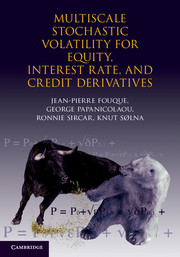Book contents
- Frontmatter
- Contents
- Introduction
- 1 The Black–Scholes Theory of Derivative Pricing
- 2 Introduction to Stochastic Volatility Models
- 3 Volatility Time Scales
- 4 First-Order Perturbation Theory
- 5 Implied Volatility Formulas and Calibration
- 6 Application to Exotic Derivatives
- 7 Application to American Derivatives
- 8 Hedging Strategies
- 9 Extensions
- 10 Around the Heston Model
- 11 Other Applications
- 12 Interest Rate Models
- 13 Credit Risk I: Structural Models with Stochastic Volatility
- 14 Credit Risk II: Multiscale Intensity-Based Models
- 15 Epilogue
- References
- Index
13 - Credit Risk I: Structural Models with Stochastic Volatility
Published online by Cambridge University Press: 07 October 2011
- Frontmatter
- Contents
- Introduction
- 1 The Black–Scholes Theory of Derivative Pricing
- 2 Introduction to Stochastic Volatility Models
- 3 Volatility Time Scales
- 4 First-Order Perturbation Theory
- 5 Implied Volatility Formulas and Calibration
- 6 Application to Exotic Derivatives
- 7 Application to American Derivatives
- 8 Hedging Strategies
- 9 Extensions
- 10 Around the Heston Model
- 11 Other Applications
- 12 Interest Rate Models
- 13 Credit Risk I: Structural Models with Stochastic Volatility
- 14 Credit Risk II: Multiscale Intensity-Based Models
- 15 Epilogue
- References
- Index
Summary
Defaultable instruments, or credit-linked derivatives, are financial securities that pay their holders amounts that are contingent on the occurrence (or not) of one or more default events such as the bankruptcy of a firm or nonrepayment of a loan. There are primarily two approaches to modeling default risk:
Structural models, which we consider in this chapter.
Intensity-based models, presented in the following chapter.
These two chapters can be read in any order. In each of these, we study the valuation of single-name credit derivatives, that is those which depend on the credit risk of a single firm, and multiname credit derivatives that depend on the credit risk of many firms. References for background on credit modeling are given in the Notes at the end of Chapter 1. The single-name material presented in Section 13.1 is from Fouque et al. (2006) and the multiname material in Section 13.2 is from Fouque et al. (2008).
Single-Name Credit Derivatives
We concentrate here on defaultable bonds already introduced in Section 1.8 using structural models built on geometric Brownian motion. We will introduce the other important single-name credit default swap (CDS) contract, in Section 14.1.5.
In structural models default occurs when the value of the firm's assets drops below some debt threshold. Such models have the benefit of providing economic intuition for the cause of default, but, in fact, they predict essentially zero-yield spreads at short maturities, because defaults are “predictable” in the sense that we can see them coming.
- Type
- Chapter
- Information
- Publisher: Cambridge University PressPrint publication year: 2011



